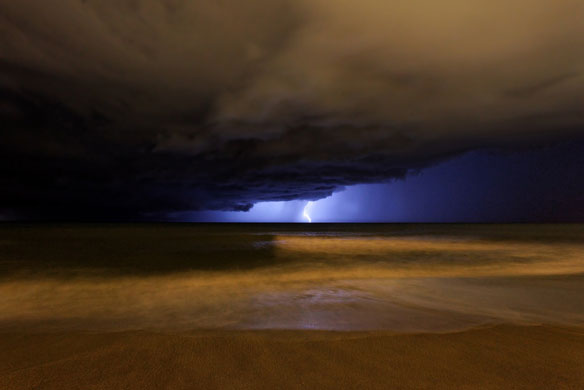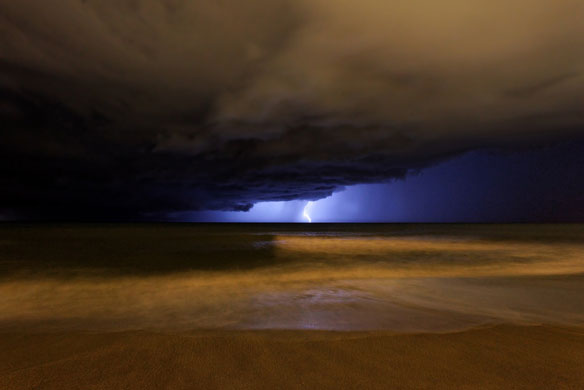
Photo source : ©© Irargerich
By Eddie Jarvis
The beaches of the Pacific Northwest are being invaded by stowaways from a nuclear catastrophe that would have made Dr. Strangelove flinch. Local politicians are pleading to Congress for help. Scientists are monitoring the Pacific Ocean and scanning the beaches with Geiger counters for signs of radiation. A dock, boat and even a Harley-Davidson have floated 5,000 miles from the radioactive disaster-zone known as Japan to beaches all over the Pacific Northwest.
No, this isn’t the plot of a new James Cameron movie. This is the fallout from the 2011 tsunami that devastated Japan, and it’s coming to a beach near you.
Although radiation has not been detected among the tsunami debris so far, scientists admit it is possible, although unlikely, for some of the debris to be contaminated by the very ill placed Fukushima Dai-ichi nuclear power plant. Luckily, most of the debris crossing the ocean was already out to sea by the time the reactor melt down occurred, and any lingering radiation will have dissipated during its journey across the Pacific.
The already costly endeavor of disposing of the debris on our beaches is made even more formidable with the ensuing threat of invasive species wreaking havoc on our ecosystem.
—Eddie Jarvis
However, some blue fin tuna caught in California five months after the Fukushima meltdown contained small amounts of radioactive cesium from the reactors, but officials said the levels were too slight to pose a health threat. Despite the reassurance, it’s safe to say that any amount of radiation is enough to make you think twice before going out for sushi.
The larger concern is over the various types of invasive species that unwillingly made the journey from Japan on a 66 foot long dock which washed ashore June 5th on the Oregon coast. The 130 ton dock was weighed down even more by the 1.5 tons of marine life that was attached to it. I’ll say it again: 1.5 TONS. You know what also weighs 1.5 tons? Your typical car, an average blue whale, or one very robust hippopotamus.
“This is a whole, intact, very diverse community that floated across from Japan to here,” quipped John Chapman, a research scientist at Oregon State University’s Hatfield Marine Science Center in Newport, Oregon. “That doesn’t happen with a log or a thrown-out tire. I’ve never seen anything like this.”
Among the various types of invasive species clinging to the dock were infamous expatriates such as the Northern Pacific star fish and an algae known as wakame, both of which can be found on the list of 100 worst invasive species. These immigrants usually hitch a ride in the ballast water of ships, making their journey on the dock somewhat of a surprise. And no, these depraved invertebrates have not mutated into Godzilla-like creatures hell bent on destruction, they are after the bread and butter of Northwest culture and livelihood: our seafood.
The Northern Pacific star fish is also known as a “voracious predator,” two words I never thought I would hear describe a star fish. Apparently, these well-traveled pests will eat anything it can get their tentacles on, including various types of shellfish. In the Derwent River Estuary in Tasmania, Australia a few stowaways turned into an infestation. It may seem unlikely that something as benign as a star fish could inflict so much damage on an entire ecosystem, but as any middle school science student can tell you, any disturbance to natural order of the food chain can cause the quintessential domino effect There is now an estimated 30 million Northern Pacific star fish in the estuary which isn’t surprising since the females can lay almost 20 million eggs a year.
Another of the docks most notorious passengers was seaweed called wakame, otherwise known as the main ingredient in Miso soup. Worst case scenario you have the ingredients for a traditional Japanese meal in your own backyard, right? But wakame grows far too quickly to harbor any delusional ideas about harvesting it. This hyperactive plant can grow up to one inch a day and has already entrenched itself in San Francisco harbor where it has driven out the native kelp that shelters marine mammals and other denizens of the deep.
Besides having a bottomless stomach and a remarkable growth rate, invasive species can introduce deadly pathogens into their adopted environment. Last October, a deadly and highly contagious virus known as Infectious Salmon Anaemia (ISA) was discovered for the first time in the Pacific salmon population in British Columbia. The disease was brought to the frigid waters of North Pacific by transporting Atlantic salmon eggs to fisheries on the West coast. A similar strain of the virus in Chile decimated the local salmon population, killing over half of the stock and costing billions of dollars in recovery. Needless to say, a similar outbreak could be devastating to a region as dependent on fishing as the Pacific Northwest.
So far, the invasive species found on the dock have proved to be an anomaly among tsunami debris. A 20 foot boat which washed ashore near Cape Disappointment in Washington State had 3,000 pounds of marine life clinging to its hull, but none of which was considered a threat.
“Most of the organisms that we have found appear to be fairly common to the Pacific Northwest,” Washington State Fish and Wildlife Officer Carl Klein said during the cleanup of the hull. However, with much more debris expected to wash ashore over the next few years, the danger is not over yet. The Japanese government estimated that there was 25 million tons of rubble caused by the earthquake and ensuing tsunami but it is unclear how much of that was washed into the ocean. The debris is too small to be accurately tracked by satellite so NOAA is using computer models to estimate where and when the debris will come ashore. Current models suggest that the debris will wash ashore on the beaches of Alaska, British Columbia, Oregon, Washington, Hawaii and possibly California. Still, much of it is a guessing game.
As the political groveling continues, tsunami debris continues to wash ashore and with no comprehensive plan of action in sight it is impossible to predict how this situation will unravel.”
—Eddie Jarvis
“We’re preparing for high amounts of debris, but we’re also preparing for little to nothing,” said Dianna Parker, a spokeswoman with the NOAA Marine Debris Program.
A beneficial side effect of the tsunami debris is the unexpected increase in tourism. By mid-June word had spread that some bona fide tsunami debris had made its way to the Oregon coast. After the public was assured that there was no radiation lingering on the massive dock, 80,000 curious onlookers descended into normally quiet Agate Beach State Park to get their photo taken next to the displaced ruin from the Far East. By this time the volunteers had scraped the dock clean of any marine life, invasive or not and unceremoniously buried it under eight feet of sand.
Disposing of the dock would prove to be substantially more challenging than scraping off the unlikely immigrants. After receiving several bids, the Oregon Parks Department awarded an $84,155 contract to remove the dock to Washington State based Ballard Diving and Salvage, which leads to the question of who is going to pay to remove all this junk?
So far the states have footed the bill for cleanup and disposal, but this had created some contention among state officials and the federal government. “The cost of the debris cleanup is going to be unknown at this point,” Washington State Governor Christine Gregoire recently stated. “The primary financial responsibility for the cleanup lies with the federal government.”
Gregoire recently released $500,000 in emergency funds on top of $100,000 that the Washington State Department of Ecology had already set aside for clean up. But as debris steadily trickles onto shore, the costs are mounting. “We don’t have the resources at the state level to do what we’re going to have to do here,” Gregoire announced at a recent news conference.
David Kennedy, assistant administrator for the NOAA’s National Ocean Service, told a U.S. Senate panel that in most cases debris removal decisions will fall to individual states. Alaskan Senator Mark Begich has dismissed Kennedy’s claim and has asked for $45 million dollars for local community groups to conduct the clean-up efforts. Instead of the $45 million he requested, the federal government authorized $250,000 to be divided among five Western states, a sum Begich calls “woefully unacceptable.”
Some communities are taking matters into their own hands. A recent beach cleanup effort in Pacific City, Oregon, volunteers were enticed to come out with promises of a wine tasting and free concert organized by the Surfrider foundation. This is certainly the best solution I have heard about so far.
It has even been suggested that the U.S. should send the Japanese government the bill for the cleanup. The State Department had dismissed this desperate idea, more than likely because nobody wants to be the guy that has to deliver that unfortunate piece of news to the Japanese who are still reeling from the widespread destruction of their country, but surprisingly the Japanese government was more receptive. According a report from the Japanese newspaper Nikkei, government officials will introduce a plan to pay back Canada and the United States for debris cleanup by the end of September.
As the political groveling continues, tsunami debris continues to wash ashore and with no comprehensive plan of action in sight it is impossible to predict how this situation will unravel. The already costly endeavor of disposing of the debris on our beaches is made even more formidable with the ensuing threat of invasive species wreaking havoc on our ecosystem.
One thing is for sure, the costliest natural disaster the world has ever seen isn’t over yet.









